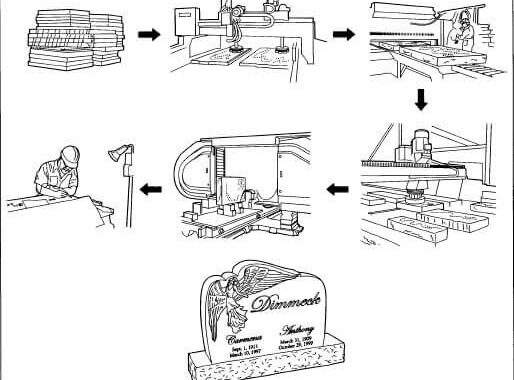The Process of Making Gravestones: Honoring Lives with Lasting Memorials
Gravestones, also known as headstones or tombstones, serve as enduring memorials to commemorate the lives of our departed loved ones. These solemn markers provide a sense of closure, remembrance, and respect for those who have passed away. But have you ever wondered about the process behind creating these significant pieces? From the selection of materials to the engraving techniques, let’s explore the intricate process of making gravestones.
1.Material Selection:
The first step in crafting a gravestone is selecting the appropriate material. Common choices include granite, marble, limestone, and bronze. Granite is highly preferred due to its durability, resistance to weathering, and ability to retain intricate details. Marble, known for its elegance, is also a popular option, although it tends to be more susceptible to weathering over time.
2.Design and Customization:
Once the material is chosen, the design phase begins. Families work closely with memorial artisans to create a customized gravestone that reflects the personality, beliefs, and interests of the departed. This involves selecting the shape, size, color, and style of the stone, as well as deciding on additional features like borders, inscriptions, and religious symbols.
3.Stone Preparation:
With the design finalized, the selected stone undergoes meticulous preparation. Skilled craftsmen use various tools and machinery to cut, shape, and polish the stone according to the desired specifications. This process requires precision and attention to detail to ensure the finished gravestone is aesthetically pleasing and structurally sound.
4.Inscription:
The inscription on a gravestone holds great significance, as it captures the essential details of the deceased’s life. Using a stencil or template, the memorial artisan carefully engraves the name, dates of birth and death, and any other desired text onto the stone. Advanced techniques such as sandblasting or laser engraving may be employed to achieve accurate and intricate lettering.
5.Additional Features:
Depending on the design and preferences of the family, additional features can be incorporated into the gravestone. These may include religious symbols, epitaphs, photographs, or even ceramic portraits. Each element is meticulously crafted and integrated into the stone to provide a personal touch and reflect the uniqueness of the individual being memorialized.
6.Finishing Touches:
After all the desired features have been added, the gravestone undergoes a series of finishing touches. The surface is polished to enhance its visual appeal and make it more resistant to the elements. Some families may opt for additional protective measures, such as applying sealants or coatings, to ensure the longevity of the gravestone.
7.Installation:
Once the gravestone is ready, it is transported to the cemetery for installation. Skilled masons carefully set the stone in the chosen location, ensuring it is level, stable, and securely anchored. The process may involve excavating a foundation, pouring concrete, or using specialized techniques depending on the cemetery regulations and local practices.
8.Preservation and Maintenance:
Gravestones are exposed to the elements, and over time, they may require maintenance to retain their beauty and integrity. Families and cemetery caretakers often engage in regular cleaning, re-leveling, and repairs to safeguard the longevity of the gravestones. This ongoing care ensures that these memorials continue to honor and preserve the memories of those who have passed away.
The process of making gravestones is a delicate and thoughtful craft that combines artistry, craftsmanship, and emotional consideration. From material selection to the final installation, every step is aimed at creating a lasting tribute to celebrate and remember the lives of our loved ones.

